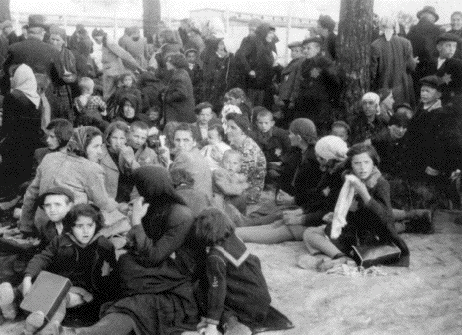
Dr. Mengele is the man on the far left
Shown in the 1944 photo above, from left to right, are Dr. Josef Mengele, Richard Baer, Karl Hoecker, and Walter Schmidetski. Richard Baer, known as the last Commandant of Auschwitz, was the commander of the main camp; his adjutant was Karl Hoecker.
Dr. Josef Mengele was one of 30 SS officers at Auschwitz II, aka Birkenau, who allegedly decided who would live and who would die in the gas chambers. If selections were made by 30 SS men, this means that Dr. Mengele only made around 3% of the selections. Yet every Holocaust survivor claims that Dr. Mengele was on duty when they went through the selection process.
Dr. Josef Mengele was nicknamed the “Angel of Death” by the concentration camp prisoners because he had the face of an angel, yet he allegedly made selections for the gas chambers at Auschwitz.

DOCTOR Josef Mengele
One of the regular readers of my blog, who is a Holocaust denier, made a comment, in which he mentioned “Mengele” without using Dr. Mengele’s title of Doctor. Holocaust believers do not give Dr. Mengele the title of Doctor because they believe that Dr. Mengele made selections for the gas chamber.

Josef Mengele, Rudolf Hoess and Josef Kramer
Dr. Mengele had a Ph.D. in Anthropology as well as a degree in medicine, which he received in July 1938 from the University of Frankfurt. He earned his Ph.D. in 1935 with a thesis on “Racial Morphological Research on the Lower Jaw Section of Four Racial Groups.”
In January 1937, Dr. Mengele was appointed a research assistant at the Institute for Heredity, Biology and Racial Purity at the University of Frankfurt. He worked under Professor Otmar Freiherr von Verschuer, a geneticist who was doing research on twins.
As the war-time director of the Kaiser Wilhelm Institute of Anthropology, Human Hereditary Teaching Genetics, located in Berlin, von Verschuer secured the funds for Dr. Mengele’s experiments at Auschwitz. The results of Dr. Mengele’s research on twins was sent to this Institute. The grant for Dr. Mengele’s genetic research was authorized by the German Research Council in August 1943.
Dr. Mengele was very nice to the little children in the camp, yet he allegedly experimented on them as though they were laboratory rats. He volunteered to do the selections at Birkenau, even when it wasn’t his turn, because he wanted to find subjects for his medical research on genetic conditions and hereditary diseases, which he had already begun before the war. He particularly wanted to find twins for the research that he had started before he was posted to Auschwitz-Birkenau.

Dr. Josef Mengele is the man on the far left
Dr. Josef Mengele was one of 30 SS officers at Auschwitz II, aka Birkenau, who allegedly decided who would live, and who would die in the gas chambers. The other 29 officers were probably not as handsome, nor as charming, as Dr. Mengele, so they never became famous.
Dr. Mengele had arrived at Auschwitz-Birkenau in early May 1943, just at the time that the second typhus epidemic was starting. Dr. Mengele himself contracted typhus while he was at Birkenau.
Dr. Mengele was known by all the prisoners because of his good looks and charm. According to Gerald L. Posner and John Ware, the authors of “Mengele, the Complete Story,” many of the children in the Birkenau camp “adored Mengele” and called him “Uncle Pepi.”
Vera Alexander, a survivor of Birkenau, said that Dr. Mengele brought chocolate and the most beautiful clothes for the children, including hair ribbons for the little girls.
Olga Lengyel, a prisoner at the Birkenau camp, wrote in her book entitled “Five Chimneys” that she had heard about Dr. Mengele from the other inmates before she saw him. Lengyel wrote that she had heard that Dr. Mengele was “good-looking” but she was surprised by how “really handsome” he was.
Lengyel wrote, regarding Dr. Mengele: “Though he was making decisions that meant extermination, he was as pleasantly smug as any man could be.”






















